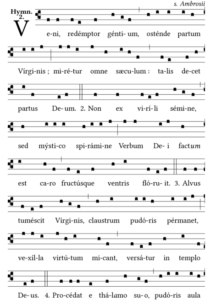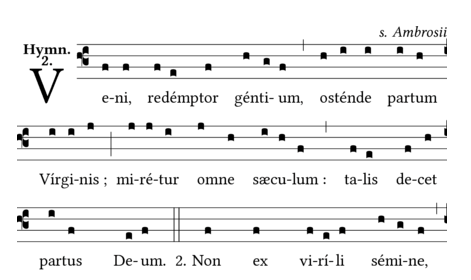 Anthony Esolen recently wrote a piece about the beauty of the older poetic and metrical hymns as compared to many modern asymmetrical and syncopated songs. I wrote a post about the beautiful hymn “Rorate Caeli Desuper” yesterday.
Anthony Esolen recently wrote a piece about the beauty of the older poetic and metrical hymns as compared to many modern asymmetrical and syncopated songs. I wrote a post about the beautiful hymn “Rorate Caeli Desuper” yesterday.
The hymn writers of old knew that in order to get a large congregation to sing together, a steady beat or meter was needed. Most modern church songs have complex, uneven rhythms. It is no wonder that many Catholics just stand there while cantors and choirs sing for them. For if the trumpet give an uncertain sound, who shall prepare himself to the battle? (1 Cor 14:8) The lyrics of most modern church songs are also far from noble or memorable; some of them are even theologically questionable.
In his article, Esolen provides excerpts of several beautiful older hymns, some well-known, others less so, but all magnificent.
For my money, the best hymn ever composed from the standpoint of textual and theological value is Veni Redemptor Gentium (Come Redeemer of the Nations), written by St. Ambrose in the 4th century. It is more widely known by the title “Come Thou Redeemer of the Earth.” Although is from the Advent season, its sweep is the full soteriological drama of Christ’s work. Jesus is not just coming; He’s redeeming, dying, rising, ascending, and reigning at the Father’s right hand. How can you all of that be squeezed into an Advent hymn? Read the lyrics below and see.
One of the beautiful things about the ancient Latin hymns is how richly theological they are. Not content to merely describe an event, they give an extensive theological vision and delve into its more hidden mysteries. Too often, we see the events of our redemption in a disconnected sort of way, but it is all really one thing and the best theology connects the dots. It is not wrong for us to focus on one thing or another, but we must not forget that it is all one thing in the end.
Without this reminder, we can easily develop a kind of myopia that overemphasizes one aspect of redemption at the expense of others. In the 1970s and 1980s it was “all resurrection all the time,” but no passion or death.
Christmas, too, has its hazards. We get rather sentimental about the “baby Jesus” but miss other important aspects of his incarnation. The passion and death are present in His birth into homeless poverty, the swaddling clothes, the flight into Egypt, and so forth. The Eucharist is evident in His birth at Bethlehem (House of Bread) and His being laid in a manger (a feed box for animals). His glory as God and His ultimate triumph are manifested in the star overhead and the angels’ declaration of glory! You see, it is all tied together, and the best theology connects the dots.
With that in mind, I present this wonderful Advent hymn, my candidate for the best hymn ever written. It can be sung to any long meter (LM) tune but is usually sung to its own melody (Puer Natus). You can find this melody in the index of most hymnals. I provide below only the English translation, but both the Latin and the English are available in this document: Veni Redemptor Gentium. I think the poetic translation reprinted below is a minor masterpiece of English literature. Enjoy this sweeping theological vision of the mystery of Advent caught up into the grand and fuller vision of redemption.
Among the theological truths treated in this brief hymn are these: His title as Redeemer, His birth to a virgin, His inclusion of the Gentiles, His sinlessness, His two natures in one person, His incarnation at conception, His passion, His death, His descent into Hell, His ascension, His seat at the Father’s right hand, His divinity and equality with the Father, His healing and sanctification of our humanity so wounded by sin, His granting us freedom and eternal life, His renewing of our minds through the light of faith, and His opening of Heaven to us.
Not bad for a mere seven verses! St. Ambrose, pray for us!
Come, thou Redeemer of the earth,
Come manifest thy virgin birth:
All lands admire, all times applaud:
Such is the birth that fits our God.
Forth from his chamber goeth he,
That royal home of purity,
A giant in twofold substance one,
Rejoicing now his course to run.
The Virgin’s womb that glory gained,
Its virgin honor is still unstained.
The banners there of virtue glow;
God in his temple dwells below.
From God the Father he proceeds,
To God the Father back he speeds;
Runs out his course to death and hell,
Returns on God’s high throne to dwell.
O Equal to thy Father, thou!
Gird on thy fleshly mantle now;
The weakness of our mortal state
With deathless might invigorate.
Thy cradle here shall glitter bright,
And darkness breathe a newer light,
Where endless faith shall shine serene,
And twilight never intervene.
All laud, eternal Son, to thee
Whose advent sets thy people free,
Whom with the Father we adore,
And Holy Ghost, for evermore.
The video below gives you an idea of what the melody for Veni Redemptor Gentium sounds like. The words in this version are slightly different from what is shown above, but the tune is perfect.


I converted to Catholicism 20 years ago and I still miss the beautiful hymns we sang in the Methodist Church.
I agree with all you said above. The worst thing though is that Mass hymns, usually led by a woman cantor, are usually in too high of a key for men. There is no way for a man to sing in the chosen keys so we just stand there. That is why I love monastic oriented hymns; they are written in a very man-friendly key!
The faithful resemble captive prisoners in the pews as they are bombarded with wannabe Bob Dylans and the trash that passes as “music” in our post-Vatican-II liturgies.
And most Catholics don’t know that we are paying multiple millions of dollars a year in royalties to the miscreants who wrote that swill.
Curiously, the USCCB will not disclose the size of such annual payments, even though that body must approve everything that appears in our hymnals. I wonder why……..
I propose an easy and permanent fix:
No songs written before 1900 shall be allowed inside the Church, anywhere.
Yes, trash was written before 1900, but it has gone the way of all flesh. Only the good music survives, prospers, and inspires.
This is the music that was stolen from us by the “Spirit of Vatican II” impresarios, with their banjos and other instruments of manipulation.
Full disclosure: I play the banjo. I do not play it in Church.
Added attraction (although our bishops are certainly not interested in money): no more royalties. All of this beautiful music is in the public domain.
A free gift! Merry Christmas!
I agree wholeheartedly. I would hope that includes Gregorian Chant.
I really enjoyed Anthony Esolen’s article. And agree with you how much theology is packed into those old hymns. We’re singing Puer Natus for Midnight Mass. Many in the congregation know Missa de Angelis ordinary so I expect it’ll be a full and joyous sound.
Father,
I chuckled when you said, “some of them (modern hymns) are even theologically questionable.” One of the priests at the seminary I attended (later the rector) used to play “Find the Heresy” with hymns, particularly newer–and often quite popular–ones.
My favorite version:
https://youtu.be/lY5EztLcSVo
Same here — a real favorite. The English version is “Savior of the Nations, Come,” It’s one of those hymns where you have to do all the verses because of the story it tells.
Veni Remptor made it into German in a slightly altered metrical version as Nun Komm, der Heiden Heiland. Virtually every North German Baroque organ composer wrote a chorale prelude based on it.
When I was studying organ ages ago with a student of Marcel Dupré, he told me it was traditional to play Bach’s prelude on it from the Orgelbuchlein every year on the First Sunday of Advent:
Here’s Marie-Claire Alain playing it: https://www.youtube.com/watch?v=3zUHNE5ajSw
And here’s another, jazzier setting by ol’ J.S.: https://www.youtube.com/watch?v=MdCKOgCK-GQ
Why Catholics don’t sing: In my humble opinion, they are not rehearsed; and/or the organist or leader of song or priest bellow into the microphone and drown them out. Re the former: when you hear a song once a year, who knows it except the choir which has been rehearsed? Re the latter: being drowned out discourages participation. I have suggested to several directors of music that they do a new hymn 3 or 4 times in a row where appropriate: Entrance, Offertory, Communion, Recessional. None has ever taken my advice. Regarding content or beauty, each hymn has to be taken individually. I understand that Silent Night was composed for a guitar because the organ had broken down. Yet it is the most favored Christmas carol.
One of the best Advent music CDs is “Advent at Ephesus” by the Benedictines of Mary, Queen of Apostles. “Come Thou, Redeemer of the Earth” is the first song. The sisters also sing “Rorate Caeli”.